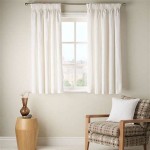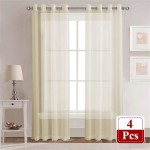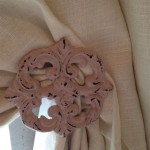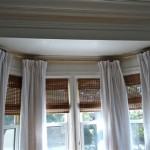Gray Living Room Curtain Ideas: A Comprehensive Guide
The living room, often the heart of a home, serves as a space for relaxation, entertainment, and social gatherings. The selection of décor within this space significantly influences its overall ambiance and functionality. Curtains, in particular, play a crucial role, providing privacy, controlling light, and contributing to the aesthetic appeal of the room. When considering curtain options for a living room, gray emerges as a versatile and sophisticated choice. Its neutrality allows it to complement a wide range of color palettes and design styles, making it a popular option for homeowners.
This article provides a comprehensive overview of gray living room curtain ideas, exploring various shades, fabrics, patterns, and hardware options to help homeowners make informed decisions that enhance the beauty and functionality of their living spaces. It will delve into the factors that influence the selection of gray curtains, including the existing color scheme of the room, the desired level of light control, and the overall aesthetic preference.
Understanding the Versatility of Gray
Gray, often perceived as a simple neutral, encompasses a vast spectrum of shades, each possessing unique characteristics. From light, airy grays to deep, charcoal tones, the versatility of gray makes it an adaptable choice for various design styles. Light grays, such as silver or dove gray, can create a bright and spacious atmosphere, ideal for smaller living rooms or spaces with limited natural light. These lighter shades reflect light effectively, making the room feel more open and inviting.
Conversely, darker grays, such as charcoal or slate gray, can add depth and drama to a living room. These tones are well-suited for larger spaces or rooms with ample natural light, as they can absorb light and create a more intimate and cozy ambiance. Medium grays, such as stone or ash gray, offer a balance between light and dark, providing a neutral backdrop that complements a wide range of colors and textures. The choice of gray shade should consider the size of the room, the amount of natural light available, and the desired mood or atmosphere.
The undertones of gray also play a significant role in its overall impact. Grays can have cool undertones, such as blue or green, or warm undertones, such as beige or brown. Cool grays tend to create a more contemporary and sophisticated feel, while warm grays evoke a sense of comfort and warmth. Identifying the undertones in existing furnishings and décor will help in selecting a gray shade that harmonizes with the overall color scheme of the living room.
Exploring Fabric Options and Light Control
The choice of fabric for gray curtains is crucial in determining their functionality and aesthetic appeal. Different fabrics offer varying degrees of light control, privacy, and insulation. Linen, for instance, is a lightweight and breathable fabric that allows natural light to filter through, creating a soft and airy atmosphere. Linen curtains are ideal for living rooms where a bright and open feel is desired, but they may not provide sufficient privacy or light control in certain situations.
Cotton is another popular choice for curtains, offering a balance between light control and privacy. Cotton curtains are relatively easy to care for and are available in a wide range of colors and patterns. They can be lined with a blackout fabric to provide complete darkness, making them suitable for living rooms that double as home theaters or bedrooms. Silk is a luxurious and elegant fabric that adds a touch of sophistication to any living room. Silk curtains have a beautiful drape and sheen, but they are more delicate and require professional cleaning.
For optimal light control and privacy, consider using blackout curtains. Blackout curtains are made from a tightly woven fabric that blocks out almost all light, creating a dark and cozy atmosphere. They are ideal for living rooms where daytime naps are common or where privacy is a major concern. Thermal curtains are designed to insulate the room, helping to regulate temperature and reduce energy costs. They are made from multiple layers of fabric that trap air and prevent heat from escaping or entering the room. The selection of fabric should consider the desired level of light control, privacy, insulation, and the overall aesthetic preference.
Incorporating Patterns and Textures for Visual Interest
While solid gray curtains offer a clean and minimalist look, incorporating patterns and textures can add visual interest and personality to a living room. Geometric patterns, such as stripes or chevrons, can create a modern and dynamic feel. Floral patterns, on the other hand, can add a touch of romance and femininity. Abstract patterns can create a more artistic and eclectic ambiance. The choice of pattern should complement the existing décor and the overall design style of the living room.
Texture also plays a significant role in the overall aesthetic appeal of curtains. Materials such as velvet, tweed or other nubby fabrics can add depth and dimension to the room, creating a more tactile and inviting space. Textured curtains can be particularly effective in minimalist living rooms, where they can add visual interest without overwhelming the space. Consider using curtains with embossed patterns or subtle weaves to create a sophisticated and understated look.
When incorporating patterns and textures, it is important to consider the scale of the room and the existing décor. Large-scale patterns can be overwhelming in small living rooms, while small-scale patterns may get lost in larger spaces. Neutral patterns such as herringbone or subtle damask patterns can add texture and dimension without dominating the room. The choice of pattern and texture should complement the existing color scheme and the overall design style of the living room.
Selecting Hardware and Accessories
The hardware used to hang gray curtains can significantly impact their overall appearance and functionality. Curtain rods, rings, and tiebacks should be carefully selected to complement the curtains and the overall design style of the living room. Curtain rods are available in a variety of materials, including metal, wood, and acrylic, each offering a distinct aesthetic appeal.
Metal curtain rods are often preferred for their durability and versatility. They are available in a wide range of finishes, such as chrome, brass, and black, allowing them to complement various color palettes and design styles. Wood curtain rods add a touch of warmth and natural beauty to a living room. They are available in a variety of wood types and finishes, allowing them to blend seamlessly with existing wooden furniture and décor.
Acrylic curtain rods offer a modern and minimalist look. They are transparent or translucent, allowing them to blend seamlessly with the wall and the curtains. Curtain rings are used to attach the curtains to the rod. They are available in a variety of materials and styles, including metal, wood, and plastic. Tiebacks are used to gather and secure the curtains, allowing natural light to enter the room while maintaining privacy. They are available in a variety of styles, including rope, fabric, and metal. The selection of hardware and accessories should complement the curtains and the overall design style of the living room, ensuring a cohesive and visually appealing look.
Considering the Overall Living Room Design
The selection of gray curtains should always be considered in the context of the overall living room design. The curtains should complement the existing color scheme, furniture, and accessories. Consider the dominant colors in the room and choose a gray shade that harmonizes with them. For example, if the living room features cool tones, such as blue or green, a cool gray with blue undertones would be a suitable choice. If the living room features warm tones, such as beige or brown, a warm gray with brown undertones would be a better fit.
The style of the curtains should also align with the overall design style of the living room. For a modern living room, consider using simple, unadorned gray curtains in a sleek and minimalist fabric, such as linen or cotton. For a traditional living room, consider using more ornate gray curtains with embellishments, such as tassels or fringe, in a luxurious fabric, such as velvet or silk. For a bohemian living room, consider using patterned gray curtains with eclectic prints and textures. The curtains should contribute to the overall aesthetic appeal of the living room, creating a cohesive and harmonious space.
The size and shape of the windows should also be considered when selecting gray curtains. For small windows, consider using shorter curtains that do not overwhelm the space. For large windows, consider using longer curtains that reach the floor, creating a more dramatic and elegant look. For windows that are unusually shaped, consider using custom-made curtains that fit perfectly. The curtains should enhance the natural light and views of the living room, while also providing privacy and light control. The overall design should balance functionality and aesthetics, ensuring that the curtains serve their purpose while also adding to the beauty of the living room.

11 Best Grey And White Curtains Ideas Living Room

Charcoal Gray Living Room Curtains Design Ideas

What Color Curtains Go With Gray Walls Top Curtain Ideas

100 Curtain Ideas To Dress Your Home Decoholic

25 Captivating Living Room With Curtain Ideas

Window Curtain Designs

30 Beautiful Living Room Curtain Ideas And Window Treatments

27 Modern Gray Living Room Ideas For A Stylish Home 2025 Edition

Alva Blue Grey Curtains Blinds

What Color Curtains With Gray Walls 12 Ideas Of 2024 Christine Dovey








